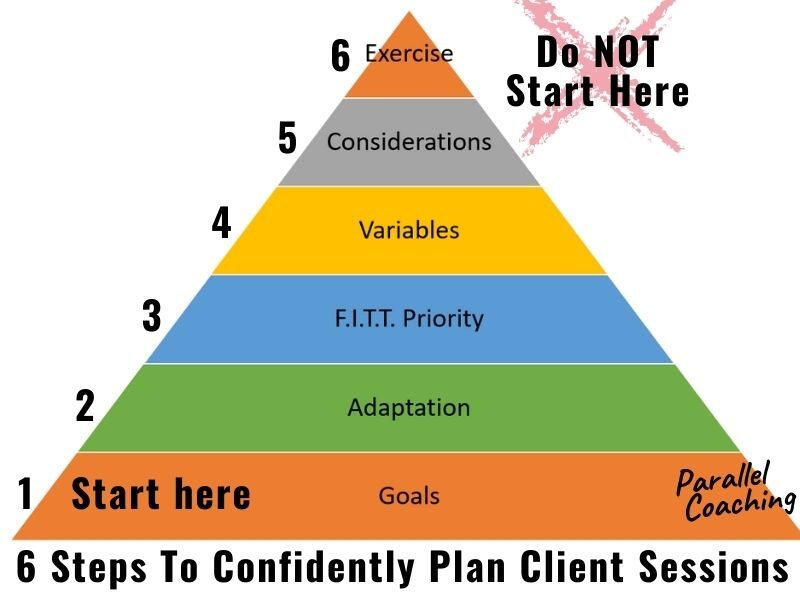A lot of FITPROs are nervous and feel they cannot confidently plan client sessions. It can be a challenge to come up with the right combination of exercises or activities. This blog post is going to provide you with six steps for confidently planning client sessions.
So if you have ever asked any of the following questions.. keep reading:
- “why is planning so complicated”
- “what is the best exercise for X?”
- “where do I start with planning for a client?”
- “how do I know these exercises will get the result?”
if you have, then listen up, as these 6 Steps will allow you to confidently plan client sessions, every time
… and it doesn’t start with exercises
Start by watching the full video tutorial, then read more below:
Here are the 6 Steps to confidently plan client sessions:

Step 1: Goal
The first place to start when planning for any client is the GOAL. You need to know their starting status (Point A), and their desired end outcome (Point B).
Without a goal, you have no target, and with no target, you cannot create a plan.
A great goal is SMART and focused as well as being measurable, managed, and monitored.
That means you need to take relevant measurements at the beginning of your client journey, partway through, and at the end. This allows you to monitor whether you are on track and whether your plan is effective at achieving the desired outcome.
Step 2: Adaptation
Now you know the start (point A) and end objective (point B) you can link it to the anatomical and physiological adaptation you hope to see as a result of training with your client.
Are they looking to increase endurance
or build get hypertrophy
or maybe looking to improve balance and flexibility
Take the goal, from the previous step and link it to your knowledge of anatomy and physiology. Consider all 8 modules from your anatomy and physiology exam revision and relate this to your client’s goal.
For example, a client that wants to increase endurance and progress from a half marathon to a full marathon, would need to challenge their aerobic energy system, they would need to challenge their cardiorespiratory system, and challenge their type 1 muscle fibres in order to improve performance towards the goal.
that’s anatomical and physiological adaptions
Step 3: FITT priority
The third step is to consider the FITT principle.
- Frequency
- Intensity
- Type and
- Time
Based on the client’s goal – which of these should they progress as the main priority.
You might decide that your client needs to gradually commit to more sessions, in which case frequency becomes your priority in the first mesocycle.
Or the client’s goal might be hypertrophy whereby a progression of intensity into a hypertrophy rep range is going to be the best focus in order to get the desired the goal
“Type” relates to the mode of exercise and the split you have chosen. For example CV or Resistance training biased, or a whole-body resistance session … or even an upper/ lower body split
You may also progress the duration of the session, which is the gradual progression of time.
Step 4: Variables
When you look at programming variables, you need to keep the previous 3 steps of planning in mind. Variables are not randomly selected; they are selected based on the goal, physiological adaptation and the FITT priority
This is the step of your programming whereby you look at in-session variables like
- Resistance
- Repetitions
- Range of movement
- Rest
- Rate
- Volume
as well as different training systems.
These variables help you to control the intensity and time of a session … which will ensure you fulfil your FITT priorities when planning the session.
Step 5: Considerations
This is whereby you remind yourself of all of the client’s individual needs.
You could consider the plane of movement and axis of movement, relevant to the client’s goal or sport.
For example, running and cycling is mostly sagittal, so a consideration to use more sagittal plan movements would be appropriate
Whereas hockey goalkeeping might be more in the frontal plane.
This is also the section that you consider the “rules” for working with your client. So if they have long term conditions there will be some exercises or intensities that are unsafe for them. So use this step to remind yourself of these.
Step 6: Exercises
And finally, we get to exercises.
At this point, the exercise is irrelevant, as long as you have adhered to every other step in your 6 steps to confidently plan client sessions
You’ll find that instead of being overwhelmed about what exercises to put in your programme, you are clear that your programme will get a result regardless of the minute detail of exercises… because all other factors are considered first.
If you find planning overwhelming
then having a strategy will make a massive difference. Which is what we offer inside our FIT-Progressions coaching programme. It is a chance to refresh your knowledge, gain a strategy and build your confidence in planning for clients
Plus you learn how to periodise your planning of training systems to allow for logical progressive overload so your client can get their goal every time.
>>>> Join us for FIT-Progressions here

Become a knowledgeable and confident FITPRO, with a clear strategy to get results with your clients every time.
There’s no more self-doubt. There’s no more guessing what to plan or how to get client results. FIT-Progressions has 8 modules and 18 video tutorials that guide you through every stage of your Level 3 Personal Trainer case study, and how to work with clients effectively.
This is for you if you’re…
- struggling to complete your coursework for PT, Yoga, or Pilates
- a newly qualified FITPRO that feels stuck or overwhelmed
- unsure where to start when planning a client session
- worrying about applying your course knowledge with a real client
- doubting you could get results and lack structure to client packages
- anxious and confused about how to get found and get busy
Click the link to find out more and join us:
https://courses.parallelcoaching.co.uk/products/fit-progressions/
Dedicated to More
Hayley “confidently plan client sessions” Bergman
Parallel Coaching
P.S. You can also find us on the following platforms:
Instagram: https://www.instagram.com/parallelcoaching
Facebook: https://www.facebook.com/ParallelCoaching
Twitter: https://twitter.com/ParallelCoach
YouTube: http://bit.ly/2F1Z1bs
Read more Planning blogs: HERE

